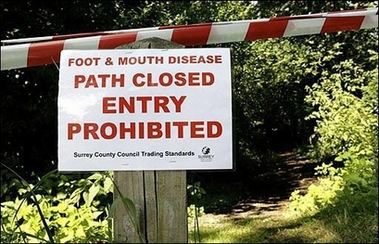Britain imposes new control zone in disease fear
Updated: 2007-08-10 10:00
 A warning sign hangs on the gate leading to Hunts Hill Farm, the third farm in the area effected by the foot and mouth disease, in Normandy, Surrey, southern England. The government-run research laboratory at the centre of Britain's foot and mouth crisis insisted on Thursday that it was not to blame for recent outbreaks of the virus. [AFP] |
LONDON -- Animal health authorities on Friday imposed restrictions around a second site amid fears that the outbreak of foot and mouth disease had spread from an initial control zone.
The new zone is just kilometres (miles) away from a research lab in southeast England where two outbreaks of the virus were confirmed last week, and comes just a day after officials eased restrictions on transporting livestock.
Debby Reynolds, Britain's chief veterinarian, would not specify exactly where the second zone was in relation to the initial Pirbright site, only saying that it was in the same county of Surrey, and outside the existing surveillance area already in place.
"This is a developing disease situation," Reynolds said in a statement.
DEFRA, the agriculture ministry, said that the zone was imposed after an "inconclusive assessment of clinical symptoms" by veterinary staff.
"The containment and eradication of FMD remains our priority. This is why we have moved swiftly to put in place a Temporary Control Zone while we investigate this development. At this stage disease has not been confirmed, laboratory results will follow."
Aside from the two confirmed cases at Pirbright in the past week, and the new zone, results were also expected soon from a third suspected outbreak which occurred close to Pirbright.
On Thursday, the government-run Institute of Animal Health (IAH) -- which shares Pirbright with private drug company Merial Animal Health -- insisted that it was not to blame for recent oubreaks of the virus. The IAH instead suggested that Merial should be under greater scrutiny.
"We have previously reported that the Institute for Animal Health works only on small volumes of virus ... whereas vaccine production by Merial is one million times greater," IAH director Professor Martin Shirley told reporters.
"All of our checks have shown this ... treatment facility to have been working appropriately at all times. ... We would be surprised to learn of the presence of any virus in the soil around our drains."
The BBC reported on Thursday evening that part of the Merial facility was built on land that was considered to be at "substantial risk" of flooding, in breach of government guidelines.
The latest news came after the government eased restrictions on transporting livestock across the country, a decision welcomed by farmers.
They are now allowed to move cattle, sheep and pigs to slaughter under strict conditions and dispose of dead livestock, which were also not allowed to be moved for fear of spreading the disease.
The National Farmers' Union also hailed what it said were prospects that a European Union (EU) ban on British meat and livestock exports could be partially lifted within weeks.
EU vets meeting in Brussels Wednesday decided to prolong the ban due to fears of a spread of the potentially-devastating disease from Britain to the rest of Europe, but agreed to review the decision on August 23.
In another sign of falling tension, neighbouring France lifted a week-old ban on moving cattle, pigs, sheep and goats imposed in response to the outbreak.
Inspectors have said there is a "strong probability" that the virus was leaked from Pirbright, although they have not pointed the finger at either the government-run lab or the private firm specifically.
But they have also indicated it is more likely the leak was somehow carried out by someone from the Pirbright site, rather than leaking through the air or in water.
The Health and Safety Executive (HSE) did not rule out sabotage, saying there were various potential routes for "accidental or deliberate transfer of material" from the site.
On Thursday, the IAH said the investigation into a suspected case of Legionnaires' disease on site had found "insignificant" levels of legionella, and labelled the inquiry a "regrettable distraction" from its work to test further samples for foot and mouth.
The victim was a worker at Pirbright, and inspectors were investigating the laboratory along with his home and everywhere else he had been in the last two weeks, to try to determine the source of the potentially fatal disease.
|
|
|
||
|
||
|
|
|
|